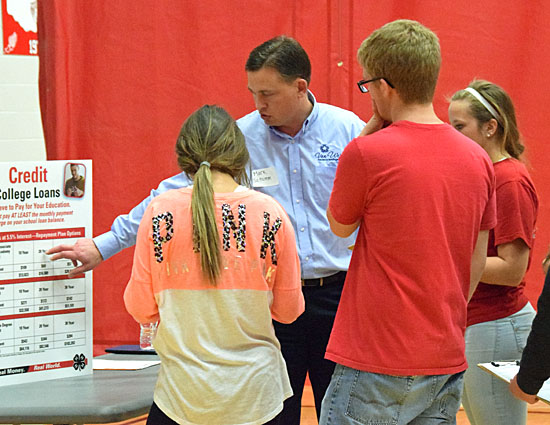Students learn about ‘real world’ finances
DAVE MOSIER/independent editor
Local high school seniors got a dose of financial reality on Thursday through the Real Money. Real World. program sponsored by the Ohio State University Extension. For some, it was a positive learning experience … for others, a nasty shock.

The OSU program provides information on a variety of financial decisions adults must make in the areas of banking, insurance, housing, investments, entertainment expenses, child care, clothing and food costs, transportation and utilities, including cell phone contracts. They also learn about the downside of debt — including credit cards and student loans — during the program, which meets the Ohio Department of Education’s “financial literacy” requirement.
Volunteers from the financial world, including bankers, insurance agents, realtors and financial advisors, provide financial information as the students progress through a series of stations during the simulation. Van Wert Safety-Service Director Jay Fleming even volunteered to provide information on the cost of city utilities — basically water and sewer rates.
OSU Extension Educator Heather Gottke said the volunteers really make the simulation work, since they’re all experts in their fields and can provide students with what goods and services cost right here in their hometown.
To begin the scenario, students start out with a basic financial situation: they’re married, with or without children, with their spouse not working, but seeking employment on a daily basis.
The scenario includes some student debt for the student, but not the spouse.
Students also choose their career, but then often find out that what they want to do in life doesn’t provide enough income for them to do the things they want to do financially.
Basically, it’s a single-parent financial set-up, and one that’s being seen all too often in today’s world.
“We put them basically in a tough situation, but that’s realistic today,” said Bob Priest, Van Wert High School government teacher, who provides an enhanced version of the OSU Extension program in his classroom. “They get an idea of how stressful finances can be.”
Priest supplements the basic program with guest speakers who provide information on a number of financial subjects throughout the school year.
It all culminates, though, with Thursday’s simulation, which is set up in the VWHS gymnasium. Thursday’s event includes a number of stations where students decide on a career, look at housing choices, purchase a vehicle and insurance, learn about child care and utility costs and save for the future and, eventually, retirement.
Lincolnview seniors went through the simulation on Thursday morning, while VWHS seniors did so in the afternoon.
VWHS senior Brittney Boaz was one of the students receiving the message that what they want to do in life has some serious financial repercussions.
Boaz, a high-achieving student, wants to be a social worker, but was frustrated by the low pay and high academic requirements (at least a master’s degree) of the profession.
Boaz found that a desire to have children and some creature comforts, while earning less than many other white-collar professionals — and even many blue-collar workers — was not all that realistic if she had to do it alone.
“Brittany doesn’t like to fail and she’s struggling right now,” Priest said of Boaz’s attempts to pair her desired career choice with her financial wishes.
In fact, the cost of having children was perhaps the biggest shock to the seniors, with Priest admitting that students’ main comments the day after the simulation was that they would probably not have children, or at least not until they could afford them.
Gottke also noted that the high cost of child care was a surprise to students, who often find that child care costs eat up a large portion of their salaries, leaving relatively little money left over even before items such as housing and transportation costs are factored in.
Overall, seniors said they received some good financial information from the program that would help them make good money decisions in the future, but many students also stated that they were often torn between what they want to do financially, and what they could afford.
Welcome to the real world.
POSTED: 05/15/15 at 6:50 am. FILED UNDER: News







